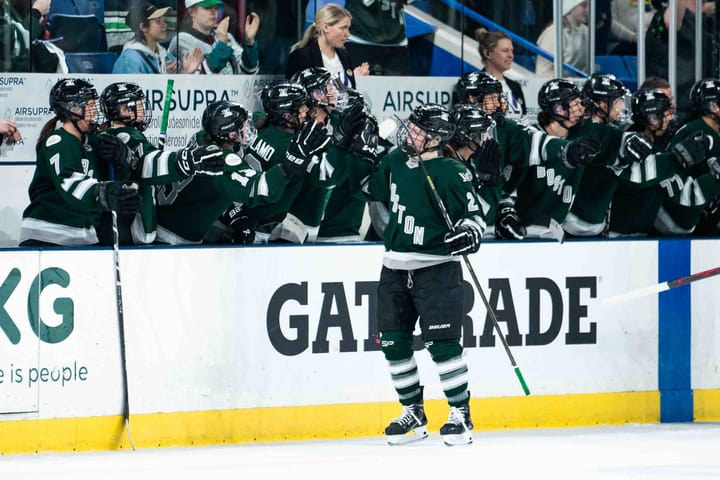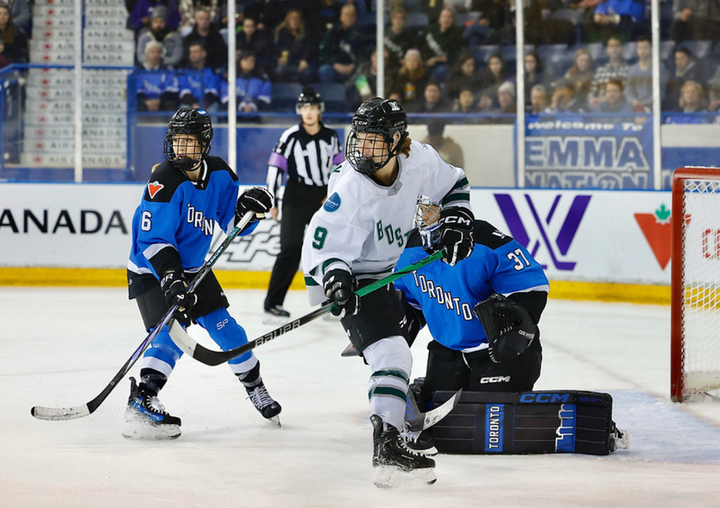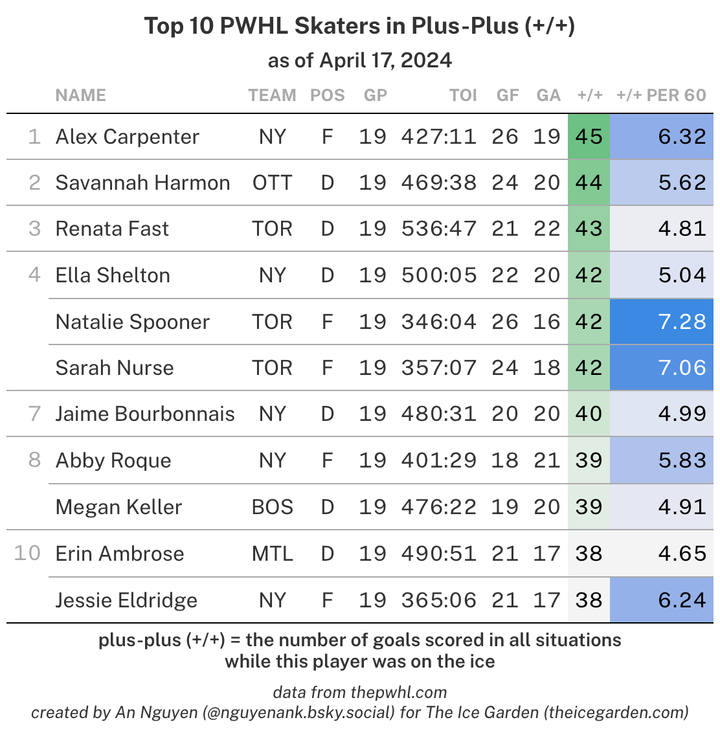NCAA Year In Review: Bemidji, Minnesota State, St. Cloud
Last place in the WCHA but 26 to 28 place in our hearts
As the NCAA women’s hockey season winds down, writers William Whyte and Gabriella Fundaro are taking an in-depth look at how each team has shaped up in 2018-19. In this post, we break down the three teams that lost in the first round of the WCHA tournament.
Bemidji
William: Like former ECAC defensive powerhouse Quinnipiac, former WCHA defensive powerhouse Bemidji had two different seasons this year. Coming up to Christmas, they’d only won five games (and only one of them was on the road), and they’d let in five goals on five occasions. After Christmas, they were 6-6-1 in conference, including a statement win against Wisconsin. Bemidji was historically a defense-first team that locked down the crease and scored opportunistically, and a team where you could clearly see what value the coaching was adding on top of the talent. So how to explain their weak start this year? Is it that despite the coaching, Bemidji couldn’t avoid relying on talent in net?
Gabriella: Through Bemidji State’s first 11 games of the season (when they were winless), they were just about on par with their opponents in shot differential, but they were badly outdone on the scoreboard. Opponents outscored the Beavers 38-14 over that stretch. They definitely regressed a bit to the mean on both ends over the rest of the season, and I think their second-half performance is a truer picture of where this team stands. They’ve got a couple of star players in forward Claire DeGeorge and defender Mak Langei, but it’s hard to win a ton of games in the WCHA without good goaltending. They’ll need to improve on a sub-.900 team save percentage to put up a better fight next year.
Stick taps: They’re 3-1-0 against Ohio State in the regular season, and had a memorable win against Wisconsin in February. And they’re only graduating two seniors, so they have a solid base for next year.
Losing an edge: Those first eleven games where they went 0-10-1 and seemed set for a last place finish in the WCHA.
FINAL: Beavers defeat the Huskies 4-2 in game 1 of the series!
— Beaver Womens Hockey (@BSUBeaversWHKY) February 16, 2019
Kaasa, Mack, DeGeorge (GWG) and Halluska all score for the Beavers.#GoBeavers #BeaverTerritory pic.twitter.com/WOJWluvuC4
Minnesota State
Gabriella: The Mavericks reached a level of success this season that hadn’t been attained in Mankato in quite a while. At 9-19-7, it was their best year yet under fourth-year head coach John Harrington, their most wins since reaching 13 in 2013-14, and their best winning percentage since 2008-09, when they went 12-19-5. Most of Minnesota State’s success this year came in the first half, starting the season off 8-7-3. The sole difference for the Mavericks this year was in net, with freshman Abigail Levy taking full control of the starting job and posting a .953 save percentage through those first 18 games. She finished the year with a .924 save percentage on 1,069 shots. Knowing that the Mavericks will have Levy in the crease for the next three years, do you think there are enough other pieces there for them to fully turn it around and make a move into the top half of the WCHA standings?
William: Five of the top seven scorers for Minnesota State were seniors, accounting for 77 of their 172 points, so although the Mavericks are looking good at their end of the ice, they need a lot of their younger players to step up up front. The good news for them there is that their highest individual goal scorer was freshman Brooke Bryant, the first person ever from San Joaquin county, central California, to sign a D1 hockey scholarship (I love those stories). There’s still a lot of work for them to do. However, all four of the WCHA teams other than Wisconin and Minnesota have shown signs of significant fragility this season, so in principle a top-four spot is an achievable goal.
Even though the Mavericks’ scoring was driven by the seniors, they felt like a young team this season, especially in the way that once Levy’s performances started to fall below their original unworldly level the team as a whole seemed to have difficulty coping. That kind of tiredness is very characteristic of a young team. The flipside of that is that we can expect a bit more resilience next year. The Mavericks may not have finished the year as strong as they started, but they’re on a lot more people’s radar than they used to be.
Stick taps: A win and a clean slate against then-No.6 Ohio State back on Dec. 1. Levy had 41 saves in the 3-0 shutout.
Losing an edge: Once the calendar turned to 2019, the Mavericks lost a lot of steam. They faced stiffer competition once they were in the thick of their conference schedule, and it showed in the results. Levy still had a good showing in the end-of-year awards, though.
Congratulations to @abbey_levy39 for making the @WCHA_WHockey Second Team and Rookie Team! #HornsUp pic.twitter.com/NKVYFMVdDx
— Minnesota State Women's Hockey (@MSUWomensHockey) February 28, 2019
St Cloud
William: St. Cloud is in this odd position of being a program where the goalies are good, even national-team good, without having the reputation of being a program with great goaltending. Katie Fitzgerald and Julie Friend have gone pro, Emma Polusny is in the US National program, and Janine Alder is positioned to take over the Swiss starting position with Florence Schelling’s retirement. Yet their defensive stats have never been that great, and this year their offensive stats have been in the dumps too. They’re around 32nd for goals for, goals against, and goal margin; they’re in the very low 30s for shots on goal per game; and their penalty kill success rate is at .768, with only Holy Cross worse in the country. (They’ve taken fewer penalties than 32 other teams, which is a bright spot, especially with a penalty kill as bad as theirs).
Looking at their stats, they seem to have two good forward lines and one good D pair and a sharp dropoff after that; and such a bad penalty kill seems to suggest a lack of depth. Is there anything wrong with St. Cloud that better recruiting couldn’t fix, and, given that they’re only an hour from downtown Minneapolis and super convenient for hockey-mad Minneapolis parents to get to, why isn’t recruiting a problem they’ve solved already?
Gabriella: I do think it likely comes down to recruiting for the Huskies, and specifically competing with other Minnesota schools for players who are out of that top tier of prospects. Many of the best U18 players are still funneling into Wisconsin and Minnesota (and programs out east), and after that, St. Cloud has to compete with Bemidji State, Minnesota Duluth, and Minnesota State for local talent.
They have been able to bring in talent, though. Looking at this year’s team, Julia Tylke is an exciting player to watch, Abby Thiessen was a big get from North Dakota, and rising sophomore Jenniina Nylund seems like she could break out in the future. But, as you’ve said, they haven’t been able to surround that talent with depth. And what depth they did have took a hit this season; the Huskies were without forward Laura Kluge and defender Rachel Herzog for a good chunk of games. That just made it all the more harder for St. Cloud to max out and take a sizeable step forward.
Stick taps: The Huskies took Minnesota to overtime back in November, but unfortunately couldn’t sneak away with a win. They did net a very respectable win just three weeks ago against Minnesota Duluth, a 3-2 decision that saw Alder make 51 saves.
Losing an edge: St. Cloud State failed to get a win in two straight overtime games against Lindenwood, but more important to their conference fate, they went 0-4-0 against Bemidji State in WCHA play, including two losses to end the regular season.





Comments ()